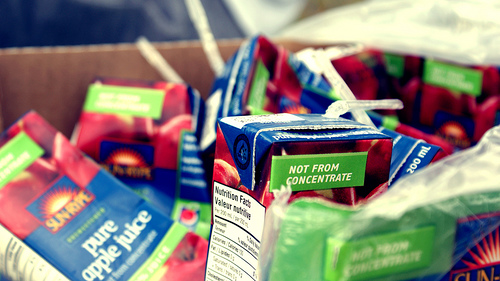Send your question to Umbra!
Q. Dear Umbra,
In the “organic” aisle I see many juices and other liquids in plastic containers. I’d like to think packaging that had its origin in paper would be better for the environment. But with everything the paper is undoubtedly coated in, is the plastic actually better? Or is it just a cheaper way to put a product on the shelf?
Krista H.
Utica, N.Y.
A. Dearest Krista,
Like a thirst-quenching melon-berry blend, this question contains many tasty nuances, if not quite as many antioxidants. Let’s take a closer look.
We typically find our liquids — juice, milk, wine, tears of a clown, what have you — contained in one of four vessels:
1. Plastic bottles, either #1 PET (polyethylene terephthalate) or #2 HDPE (high-density polyethylene). As plastics go, these are the relative good guys: They are easily recyclable and pose few health risks. Some major beverage companies are also experimenting with bioplastics, an uncertain science whose pros and cons I’ve previously discussed.
2. Paper cartons or boxes, which come in two forms. Aseptic, also known as shelf-stable — think juice boxes, soy milk containers, and the like — can be stored unrefrigerated and are made of several layers of paper, polyethylene plastic, and aluminum. Gable-top — think milk cartons — are made of paper coated with polyethylene. We should really think of both of these as “paper-plastic.”
3. Aluminum cans, which are resource-intensive to produce but eminently recyclable.
4. Glass bottles, which are … well, glorious glass. But stay tuned for a surprising twist!
What’s that, you want the surprising twist now? OK. Although you did not ask about glass, several scholars — including this gent from Tufts University [PDF] — have found that individual glass bottles have a far greater eco-impact than their plastic or paper-plastic brethren, primarily due to their weight and the associated shipping impacts. Good old aluminum also fares badly in studies, though not as badly as glass. Shocking, I know.
Which brings us back to the two materials in your question. Plastic bottles have reigned supreme since the 1960s. Aseptic packaging, which is 70 percent paper, was not introduced to the U.S. until the 1980s, and is now surging in popularity. Manufacturers of beverages and medicines like this option because it is lightweight, relatively cheap, and preserves flavor and quality. The bottling plants are also less costly to run, after a higher initial outlay. On top of that, the industry frequently boasts that paper is a renewable resource from “growing forests” (as opposed to those lazy forests that stand around and do nothing).
But here’s the hitch: Paper cartons are only recyclable in about one-third of American households. This number is on the rise, and you should check with your municipality or Earth911 to find out if carton recycling is an option where you live. But at the moment, plastic has a leg up in that area.
Despite that, aseptic (“paper”) packaging wins the eco-battle. One life-cycle analysis [PDF] conducted in Spain, for instance, compared aseptic packaging, HDPE plastic, and glass from production to disposal, and found that the first had the least eco-impact. Other studies draw similar conclusions, although many are industry-commissioned.
So “paper” cartons can be the better option, especially if your community recycles them. But am I recommending that you start buying juice boxes willy-nilly? No. What we all must do, Krista, is reduce the packaging we buy and use. No more tiny this, individual that. When you can, buy in bulk. Drink from a reusable cup or canteen. Maybe even try your hand at making your own juice (or soy milk!). That’s one sure way to know what’s going down the old gullet.
Bibulously,
Umbra





